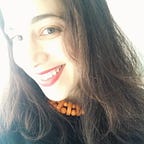Chapter 10: Buried Treasure
When I was a very little girl, my parents nicknamed me Hector the Collector, after the Shel Silverstein poem from his book of children’s poetry published the year before I was born. Hector, like me, was — depending on your perspective — either an inveterate junk collector or someone who saw the magic in discarded treasure. My parents went with “garbage hound.”
I don’t know why I picked up sticks and gum wrappers and broken toys to bring home. I don’t remember how I started. I don’t know that I ever really stopped. This is not to say my home is full of trash, or that I pick up everything I see on the sidewalk so I can take it home and turn it into something else. But at the bottom of every bag I own is a pile of old softening receipts, like leaves before they crisp up in autumn. Nestled inside are lip balm tubes, miniature bottles of lotion or ketchup I couldn’t resist swiping, scraps of paper on which I scribbled something I absolutely had to remember, pages of magazines, weird pretty trinkets that briefly seemed necessary for some greater purpose. I can clean out a bag but it doesn’t stay that way for long. Slowly, like gentle layers of sand, the strata return.
You might say I was a magpie, but you’d be wrong: Magpies don’t collect shiny objects anymore than any other bird does. Shiny things make magpies nervous.
Nor am I a collector, Hector aside. There’s no pattern to what I have, no 400 tiny spoons or 1000 perfectly archived matchbooks. Also not a hoarder, at least not in the pathological sense of anyone you’ve seen on television. No teetering towers of newspaper threaten to crush me, and I do not own every Raisin Bran box I have purchased since 1987.
What I have is an emotional attachment to objects, nearly all of them, which makes me unsure which to throw away, which to use, which to save for later. It was never clear to me what purpose all those objects served, that loose collection of puzzle pieces that did not fit together into any sort of puzzle I could imagine.
But then, one day, I went to plan a road trip to the desert.
“I just heard about this amazing thing,” said my friend, “so we have to make sure we visit it while we’re down there.”
Memory of it clattered into consciousness, like a marble rolling out from under a dusty sofa. “You’d never heard of it before?” I asked.
“Nope. A lot of California is still new to me.”
I had never been there, had never visited this place or even the desert that surrounded it. What I knew was minimal at best — a found photo, a snippet of someone else’s visit, an idea of a trip one day in the unspecified future. I spread my fingers through the memories and facts I’d gathered, all the shiny images and ideas of a place and a time that had never been mine, and suddenly a puzzle fell into place. A road opened up before me, not leading me away from home so much as deeper into the story I had been building for years. One woman’s trash, I told myself, is this woman’s treasure map.
